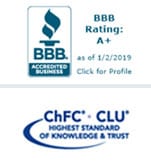
How do you file taxes for a deceased family member?
When someone close passes away, taxes are the last thing on your mind. Unfortunately, the death of a family member often raises tough financial questions regarding the deceased’s assets and estate. Here’s a quick guide to get you through.
1. Determine if the deceased is required to file
People with income below a certain threshold are not required to file a tax return. In 2019, individuals who meet the following criteria do not need to file:
Single Filers:
- Under age 65, income under $12,200
- Age 65 or older, income under $13,850
Joint Filers:
- Both under age 65, income under $24,400
- One age 65 or older, income under $25,700
- Both age 65 or older, income under $27,000
Married Filing Separately:
- Any age, income under $5
Head of Household:
- Under age 65, income under $18,350
- Age 65 or older, income under $20,000
Qualifying Widow or Widower with Dependent:
- Under age 65, income under $24,400
- Age 65 or older, income under $25,700
However, even if your loved one does not meet income requirements, they may need to file if they were self-employed, purchased health insurance on the marketplace, or were paid a 1099-MISC form. Additionally, filers who are not required to file may benefit from doing so either because they are due a refund or because they qualify for the earned income tax credit.
2. Assess sources of taxable income
Income is more than just your salary. Common sources of taxable income include jobs, pensions, investment accounts, non-Roth retirement accounts, annuities, disability payments, rental properties, and self-employment. In some cases, social security benefits may also be taxable, so it’s important to look at the entire picture of your loved one’s finances.
3. Prepare the return
Tax returns for the deceased are filed on the standard Form 1040, however, there are a few notable differences in the way the form is filed. If you are the executor, sign on behalf of the deceased as the estate representative. If you are a surviving spouse and file jointly, add the words “filing as surviving spouse” after your signature. If there is a separate executor, they should sign as well. If there is no surviving spouse or court-appointed executor, and you have taken charge of sorting out the deceased’s assets, you can sign as a personal representative.
The deceased person is still eligible for the same credits and deductions they would have claimed if they were living. Additionally, surviving spouses may be entitled to several deductions and credits that can reduce their tax bill (or increase their refund). A professional tax preparer can help you determine if you qualify.
4. Claim the refund
Surviving spouses who file jointly with the deceased do not need to file additional forms to claim a refund. However, executors and personal representatives are required to include supporting documents with the return. Executors who wish to claim a refund should attach a copy of the document that appoints them as executor. Personal representatives who are not court-appointed should file IRS Form 1310 with the return.
5. File on time
In most cases, tax returns for the deceased are due at the same time as everyone else’s, that is, April 15th of the following year. The only exception is if the person’s death occurs between January 1st and April 15th and they had not yet submitted a return for the prior year. In that case, two returns must be filed on their behalf: one for the last year, and one for the current year.


Sara McKinney
saractag@gmail.com
As Cowen Tax Advisory Group’s Digital Content Marketing Specialist, Sara provides in-house copywriting and manages the company’s electronic records system, email marketing, and blog.




